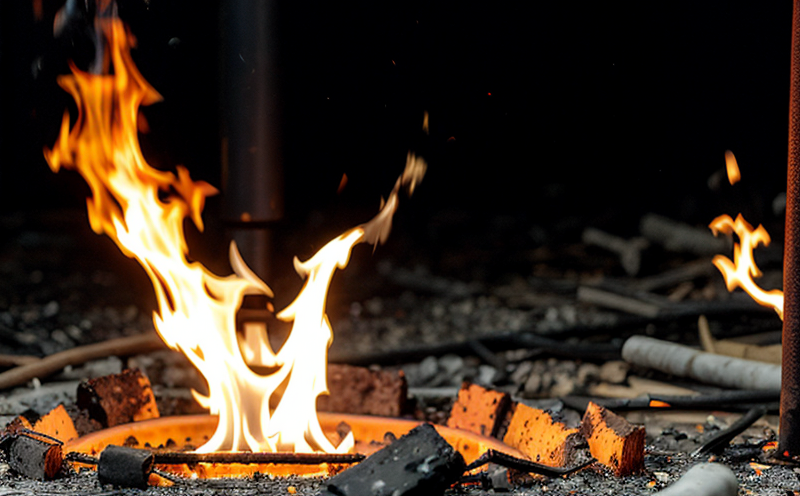Toy Fabric Burning Behavior Evaluation
In the world of toy manufacturing and quality assurance, ensuring that products are safe for children is paramount. Flammability testing plays a crucial role in this regard by assessing how fabrics used in toys behave when exposed to fire or heat sources. This service focuses specifically on evaluating the burning behavior of fabric materials intended for use in children's toys.
The process involves controlled laboratory tests that simulate real-world conditions under which the toy might be handled or used. The objective is to determine the extent and rate at which a fabric ignites, burns, and extinguishes when subjected to specified sources of ignition such as matches, cigarettes, or open flames. By understanding these characteristics, manufacturers can make informed decisions about material selection and design modifications aimed at enhancing product safety.
Flammability testing is governed by international standards designed to protect public health and safety. These guidelines provide precise procedures for conducting tests and interpreting results. Adherence to such regulations not only ensures compliance with legal requirements but also builds consumer trust in the quality of goods produced.
The methodology typically begins with preparing a representative sample of the fabric used in toys. Specimens are cut into standard sizes suitable for insertion into the testing apparatus. Once prepared, they undergo rigorous examination using specialized equipment capable of replicating various types of ignitions and measuring key parameters like burn rates, flame spread distances, and residual char formation.
Results from these tests serve multiple purposes. They help identify potential hazards associated with specific fabrics, guide improvements in manufacturing processes, inform labeling decisions regarding fire risk levels, and contribute to overall product development strategies focused on safety enhancement.
To illustrate the importance of this service, consider a case study involving a popular brand of children's slippers made from synthetic fibers. During routine flammability checks conducted according to relevant standards, it was discovered that certain batches exhibited unexpectedly high flame spread indices compared to previous versions. Armed with this information, engineers were able to pinpoint the exact cause - a change in supplier leading to variations in raw material composition. Consequently, adjustments were implemented to ensure consistency across all production runs, thereby maintaining consistent safety performance.
Understanding how different factors affect burning behavior is essential for effective testing and analysis. Some critical variables include fabric type (natural vs synthetic), thickness, colorant content, weave structure, and finishing treatments like flame retardants. Each of these elements interacts uniquely with heat sources during a burn event, influencing the outcome significantly.
For instance, darker colored fabrics tend to absorb more radiant heat than lighter ones, potentially leading to faster ignition times or increased flame propagation rates. Similarly, tightly woven structures may restrict air flow around the sample, reducing overall heat transfer efficiency and altering burning patterns altogether. Such insights enable manufacturers to tailor their testing protocols appropriately based on expected end-use scenarios.
Applied Standards
| Standard | Description |
|---|---|
| ISO 13565-1:2009 | Flammability (surface ignition) of fabrics used in children’s clothing and associated products - Part 1: Cone test |
| ASTM F1927:2018 | Standard Test Method for Determining Flame Spread and Smoke Developed Using the Modified Cone Burn Apparatus |
| EN 16943:2015 | Flammability of textiles used in children's clothing - Cone test |
| IEC 62196:2007 | Electrical appliances for infants and young children - Safety requirements |
Industry Applications
The demand for reliable flammability testing services is driven by the need to comply with stringent regulatory frameworks across various jurisdictions. Regulatory bodies like the Consumer Product Safety Commission (CPSC), European Union (EU) directives, and China's National Standards Administration all enforce rigorous safety measures aimed at safeguarding young consumers.
Manufacturers of toys must adhere strictly to these guidelines during product development stages. By incorporating early-stage evaluations into their workflows, companies can proactively address any issues before mass production begins. This proactive approach minimizes costs associated with recalls and rework while enhancing brand reputation through demonstrated commitment to quality assurance practices.
In addition to regulatory compliance, flammability testing contributes significantly to product innovation by providing actionable data that guides improvements in materials selection and design iterations. For example, incorporating advanced flame retardant technologies or exploring alternative fabric compositions can lead to safer yet equally appealing alternatives for end-users.
Furthermore, transparency regarding safety assessments fosters trust among parents and caregivers who rely on credible information when purchasing gifts or educational tools for their children. Positive perceptions about a company's dedication to safety can translate into increased market share as consumers become more inclined towards brands known for prioritizing child welfare.
Environmental and Sustainability Contributions
- Reduces waste by identifying non-compliant materials early in the production cycle, preventing unnecessary manufacturing runs.
- Promotes sustainable practices through informed decisions based on test results, encouraging manufacturers to choose eco-friendly alternatives when possible.
- Facilitates compliance with environmental regulations that require certain products to meet specific flammability thresholds.
- Encourages the development of safer and more durable materials, ultimately reducing the need for frequent replacements or repairs.





